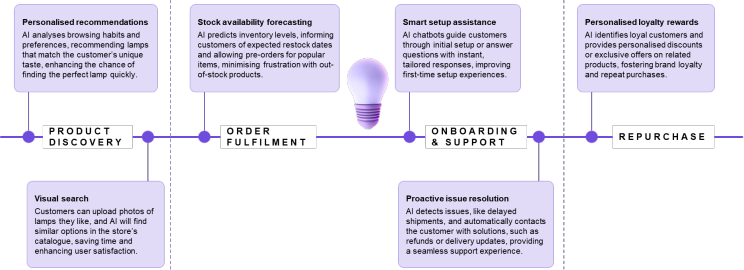Introduction
When approaching AI and its applications within eCommerce and retail, there is a careful balance to strike between ambitious forward-thinking and the practicalities of today. Industry conferences, articles, and newsletters often preach about AI’s revolutionary benefits to the industry. But what does this mean for the decisions industry leaders need to make today? How can organisations embark on an AI journey sustainably, ensuring gradual and impactful integration?
You often see the concept of 'tech without the trading' emerge in the eCommerce world, where technology is commissioned at a Senior Leadership level without the necessary steps to operationalise it and realise day-to-day commercial and operational benefits.
Alas; AI is not a silver bullet for all business and customer challenges; it isn’t a new division or separate team (yet). Instead, it is a powerful tool that augments and enhances how your business and teams operate. A helpful metaphor is to think of AI as a new team of talented graduates: resourceful and creative, yet requiring support, resources, and clear objectives to deliver value. This approach to AI demands both a strategic outlook and a practical, integrated application across the business.
So, how can we in 2025 leverage the technologies at our disposal to benefit our customers, teams, and wider business performance?
Differentiation
In the competitive eCommerce landscape, differentiation often hinges on three pillars: Price, Product, and Experience. While AI can support trading teams with commercial insights around price and product trends, the customer experience stands as the true differentiator. AI’s potential to enhance every stage of the customer journey, from discovery to post-purchase support, provides brands with a unique opportunity to stand out by delivering personalised, seamless interactions that align with modern consumers’ expectations.
Picture the scene: you’ve been on the hunt for a new lamp for weeks. After searching through a range of retailers, scrolling through product catalogues, entering different search terms, and switching filters, you finally find the perfect lamp. But alas, it’s not available online. Now, all you can do is enter your email and wait for it to come back in stock. Not knowing whether this will ever happen, you’re left wondering if the product line is over or if there’s a global supply chain crisis. Do you stick with your search or abandon your quest for the coveted lamp?
Overall, this is not a satisfying or positive customer experience. You didn’t get your lamp, you now know it exists but can’t have it, and all other lamps you see will be subpar.
On the flip side, the lamp retailer didn’t get to sell their lamp, didn’t create a new happy customer, didn’t build a long-term relationship for all their homeware and lighting needs, and didn’t collect valuable insights on this customer.
Behind the curtain for this retailer is an eCommerce operations team, ambitious, talented, and full of ideas, yet bogged down by menial tasks to maintain their site's experience, such as merchandising and general site hygiene. They work hard, yet their talents are underutilised.
All the great ideas, ambition, and capability are nothing if they don’t have the time and resources to execute. The team is overworked, underutilised, and morale is low. Common time drains include stock updates, tagging new products, and demand forecasting.
This is where the three worlds collide, feeding into each other and further exacerbating the problem.

AI provides the tools to:
- Check location and stock availabilityof nearby stores, always presenting customers with options on how to purchase from you.
- Forecast product availability, effectively managing customer expectations.
- Enhance product and site search, especially for retailers with large or niche product catalogues. AI can provide a clear fix with natural language models making the connection between customer queries and your catalogues a smooth experience. Additionally, AI can venture into augmented reality, enabling customers to take or upload an image to match relevant products in your catalogue.
- Effectively collect and manage customer data, maintaining a relevant and personalised relationship with your new lamp-owning customer.
Your team now has the ability to maintain a top-quality BAU (Business As Usual) customer experience. Utilising AI tools, they can automate complex interactions, data flows, and triggers that have been consuming the majority of their working hours.
They are now free to engage in bigger and better things, executing ambitious ideas, testing concepts in a safe, analytical, agile, and cost-effective manner. Or, more simply, they aren’t working themselves into burnout to maintain BAU operations. According to a survey conducted by CharlieHR, an alarming 82% of employees in the tech industry feel close to burnout, and are in desperate need of some support.
AI transforms the customer experience in two key ways: directly, by introducing new capabilities like smarter search, accurate forecasting, and personalised recommendations, and indirectly, by automating repetitive tasks, freeing up your team’s time. This means your team can focus on strategic, high-impact initiatives without being bogged down by maintaining daily operations. With AI handling the heavy lifting, you’re not only delivering a better customer experience but also empowering your team to innovate, test bold ideas, and build lasting relationships, starting with something as simple as getting that lamp into your customer’s hands.
Benefits across the customer journey.
AI doesn’t just enhance isolated moments in the customer experience; it transforms the entire journey, from the first interaction to post-purchase loyalty. It allows your teams to create a seamless, efficient, and personalised experience, not only for typical scenarios but even for challenges like managing out-of-stock items. With AI integrated into your operations, every stage of the customer journey becomes an opportunity to delight and exceed expectations.
- Purchase: AI enhances product discovery with dynamic content, personalised recommendations, and tools like visual search, making it easier for customers to find and purchase the products they want. Currently 35% of annual sales at Amazon are from AI-driven recommendations.
- Order Fulfilment: From purchase to delivery, AI enables businesses to manage expectations, optimise logistics, and equip customer service teams with real-time data to ensure smooth, satisfying fulfilment experiences.
- Onboarding & Support: AI supports customers by providing timely assistance and personalised guidance, enhancing their experience from initial setup through continued product use.
- Repurchase: AI fosters customer loyalty by recognizing returning customers and tailoring interactions, providing relevant incentives, and making repeat purchases as frictionless as possible.
Of course, the examples highlighted here are just the beginning and far from the definitive list of AI’s applications across the customer journey.
AI applications across the customer journey:







